 General
General  General Archive
General Archive  Top Cleveland Sports Figures, By the Numbers - #9
Top Cleveland Sports Figures, By the Numbers - #9
This is one installment in a team effort by The Cleveland Fan, highlighting the top local sports figures by jersey number. Please weigh in with your thoughts on the "Boards". As David Letterman would say, "For entertainment purposes only; please, no wagering"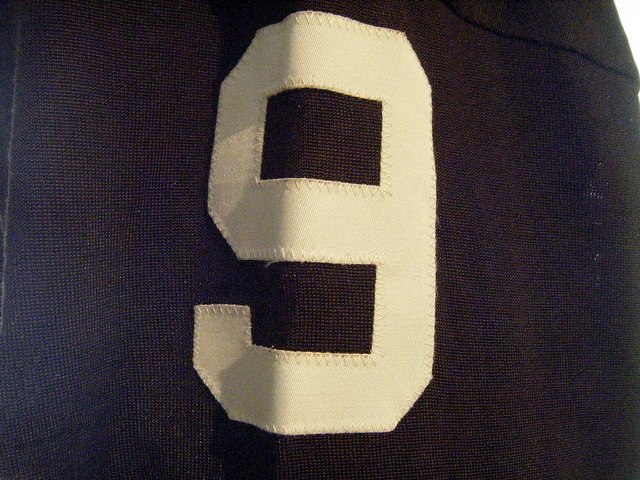 If this town has anything like “glory days” for those fans born after 1965 or so, it’s got to be that stretch in the mid-90’s when the Indians were a powerhouse, and The Jake was the place to be 81 times every summer...and a few more times in October. The last two articles in our series have featured Lofton (#7) and Belle (#8) from that team, and I fully expected to be following suit at #9 with Carlos Baerga. That is, until someone reminded me of the greatest hockey player in Cleveland history.
If this town has anything like “glory days” for those fans born after 1965 or so, it’s got to be that stretch in the mid-90’s when the Indians were a powerhouse, and The Jake was the place to be 81 times every summer...and a few more times in October. The last two articles in our series have featured Lofton (#7) and Belle (#8) from that team, and I fully expected to be following suit at #9 with Carlos Baerga. That is, until someone reminded me of the greatest hockey player in Cleveland history.
Say what? Yes, youngsters, Cleveland used to be a hockey town, and a good one....with a championship team, and a bonafide star in #9, Fred Glover. We’ll get to Baerga in a minute, as well as a couple of also-rans who wore #9, but first we need to talk about what used to happen down at E. 36th and Euclid at The Cleveland Arena. Because this series really should have a hockey player included as one of the top Cleveland sports figures, and let’s face it....this is our only shot.
Our Top #9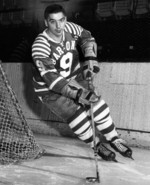 Fred Glover was born in Toronto in 1928, and was playing professional hockey by the time he was 18. In his first season in the American Hockey League (1948-49) he led his Indianapolis Capitals in goals and assists at the age of 21, the first of eight times he would top his team in scoring. He was a part-time player on the Stanley Cup champion Detroit Red Wings in 1952, and then in 1953, he was traded by the NHL Chicago Black Hawks to the AHL Cleveland Barons.
Fred Glover was born in Toronto in 1928, and was playing professional hockey by the time he was 18. In his first season in the American Hockey League (1948-49) he led his Indianapolis Capitals in goals and assists at the age of 21, the first of eight times he would top his team in scoring. He was a part-time player on the Stanley Cup champion Detroit Red Wings in 1952, and then in 1953, he was traded by the NHL Chicago Black Hawks to the AHL Cleveland Barons.
That began a 16-year stretch in Cleveland that would see Glover re-write the AHL record books as a player, while his Barons won the Calder Cup, (the AHL league championship) four times. When Glover hung up the skates in 1968, he held the AHL career records for games played (1201), goals (520), assists (814), total points (1,334), and penalty minutes (2,402). 45 years later, he still ranks second in the first four of those categories. Career Stats
The Barons’ acquisition of Glover paid immediate dividends, as the 5’,9”, 160 lb. center/forward scored 90 points in his first 84 games over his first season and a half with the club, and the Barons won the Calder Cup both years. Glover appeared in six consecutive All-Star games beginning in 1954-55, and was named the winner of the Les Cunningham Award, the league’s MVP trophy, three times.
A Playoff Habit
Glover’s 17 Calder Cup appearances are a league record, and his seven postseason All-Star team berths and five first-team selections are the most for any forward in AHL history. 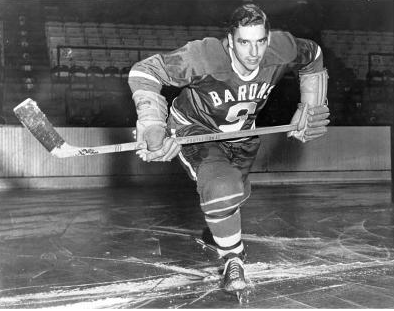
Without taking anything away from Glover’s heroics as a member of the Cleveland Barons, it should be acknowledged here that the AHL was a step down from NHL hockey. There were only six teams and 120 jobs in the NHL at the time, and the AHL functioned as a feeder system of sorts for the Detroits and Torontos of the world.
Glover appeared in 92 NHL games in his career, none after 1952-53. “I guess they figured I was too small and too slow for the NHL,” Glover said. “I think I could have made it. After all, there’s nothing more important than being able to put the puck in the net.”
NHL Coach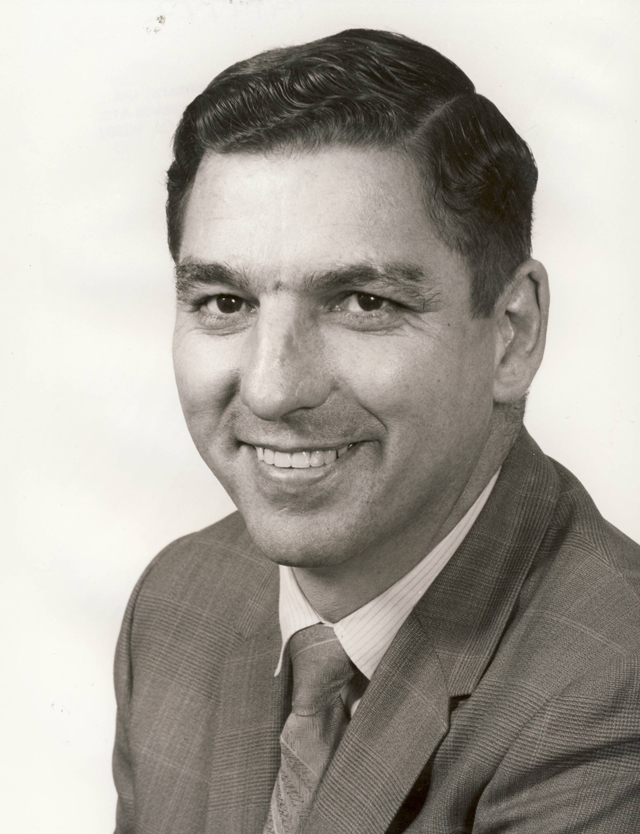 In 1968, the NHL Oakland Seals General Manager Frank Selke Jr. knew of the reputation of Fred Glover, and hired him after an interview on a park bench in St. Louis to try to turn around the miserable Seals franchise, which had won just 15 of their 74 games the previous year. “Fred had a fantastic record in the AHL, not only as a competitor, but as a handler of men,” said Selke at the time of the hire. The Seals went 29-36-11 in Glover’s first year as coach, and took the L.A. Kings to seven games in the first round of the playoffs. Glover won praise from all corners of the league for his turnaround of the Seals, and The Hockey News named him NHL Coach of the Year.
In 1968, the NHL Oakland Seals General Manager Frank Selke Jr. knew of the reputation of Fred Glover, and hired him after an interview on a park bench in St. Louis to try to turn around the miserable Seals franchise, which had won just 15 of their 74 games the previous year. “Fred had a fantastic record in the AHL, not only as a competitor, but as a handler of men,” said Selke at the time of the hire. The Seals went 29-36-11 in Glover’s first year as coach, and took the L.A. Kings to seven games in the first round of the playoffs. Glover won praise from all corners of the league for his turnaround of the Seals, and The Hockey News named him NHL Coach of the Year.
One more Fred Glover anecdote: Glover continued as coach of the Seals (and later the California Golden Seals) for four years, sticking around even after the notorious Charlie Finley bought the team in 1970-71. As Brad Kurtzberg tells it in his book on the Seals, a lot of team employees had problems with the controversial new owner, but not Fred Glover. “Working for him was a piece of cake,” Glover said of Finley. “I can’t say enough about the man. I talked to him differently than other people did. He knew when I said no, it was no. I told him off twice. He respected people who weren’t afraid to stand up to him. Finley was famous for chewing people out, but only if you didn’t stand up to him.”
Finley respected Glover enough to lure him back to the Seals in 1972, after Glover had been fired by Seals GM Garry Young three games into the ‘71-‘72 season. Glover finished that year as coach of the L.A. Kings, and had moved on to be the GM of the new WHA Cleveland Crusaders when Finley called him back to California. He remained as coach until the Seals were sold to the NHL in 1974, at which point he retired to Hayward, California where he resided until his death from cancer in 2001 at the age of 73.
---
Runner-Up (by an eyelash)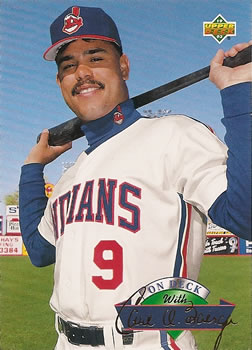 Carlos Baerga - Indians 2B - (1990-1996 and 1999)
Carlos Baerga - Indians 2B - (1990-1996 and 1999)
Baerga played seven seasons for the Indians, mostly at second base, in the heady days of the mid-90’s at Jacobs Field. He will always be remembered fondly in Cleveland for his remarkable offensive production, especially in the four years from 1992-95, when he was one of the best pure hitters on a ridiculously strong offensive team.
Baerga hit .312 or better in each of those four seasons, as the Tribe juggernaut was coming together. In 1992 he was the only .300 hitter in the everyday lineup. By 1993, Kenny Lofton (.325) joined him. In 1994, Albert Belle (.357) made it three, and by 1995, six Indians regulars hit over .300 for the season. The constant was Baerga, who made three All-Star teams in that stretch, and won the AL Silver Slugger Award for second basemen in ‘93 and ‘94.
Carlos was a run-producer as well, putting up eye-popping numbers for any middle-infielder of any era. Most teams put their best RBI man in the third spot in the batting order, and that’s where Baerga found himself, even in a lineup that included Belle, Murray, Thome and Ramirez. In ‘93-’94, he became the first second baseman since Rogers Hornsby to put up 200 hits, 20+ homers, 100+ RBI and a .300 batting average two years in a row. After his stellar ‘93 campaign, he finished 10th in the AL MVP voting.
To me, Baerga always seemed to have an uncanny knack of putting the bat on the ball, even when he was behind in the count and swinging defensively. One (carefully selected) example of that was his 1995 season, when in 600 plate appearances, he struck out just 31 times. 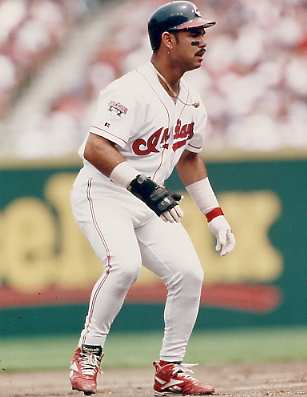 It must be said that Baerga’s offensive productivity was enough to keep him on the field in spite of the fact that he was not a great defensive player. While he led the AL in assists for second basemen three times between ‘92 and ‘95, he also finished either first or second in the AL in errors at 2B five years in a row.
It must be said that Baerga’s offensive productivity was enough to keep him on the field in spite of the fact that he was not a great defensive player. While he led the AL in assists for second basemen three times between ‘92 and ‘95, he also finished either first or second in the AL in errors at 2B five years in a row.
Most Tribe fans of that era will remember the switch-hitting Baerga becoming the first major leaguer ever to hit home runs from both sides of the plate in the same inning...against the hated Yankees no less. (That feat has been matched twice since).
Perhaps not as many will recall Baerga limping to the plate as a pinch hitter in the final series at Municipal Stadium in October of 1993. He had 199 hits on the season and was not expected to play that weekend due to a painful leg infection, but the Indians trailed the White Sox 4-0, and they had a rally going in the 8th inning. Baerga legged out a bunt on the bad wheel for his 200th hit, advancing the two baserunners and prolonging what turned out to be a short-lived rally, and a loss.
The 72,454 fans (yours truly among them) who were assembled to say goodbye to the old lady on the lake roared their approval of the effort and the milestone. It was typical of the way Baerga played the game during those years, but when the Indians management stopped seeing that same effort and attitude out of Carlos Baerga some three years later, they made the decision to sell high.
Suddenly Over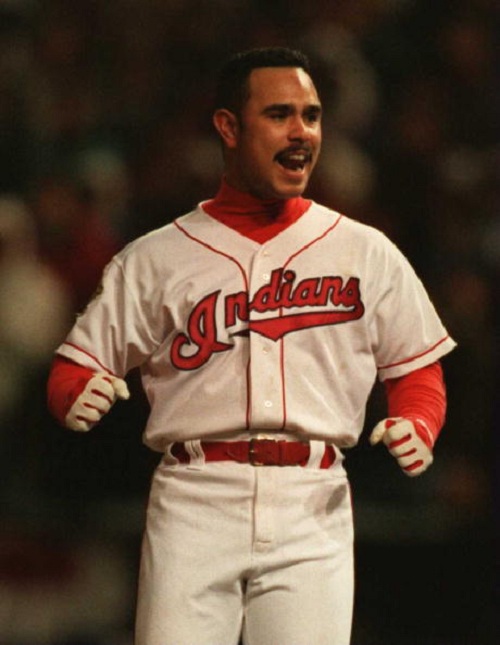 Baerga played 100 games in Cleveland in 1996, but his HR and RBI numbers had declined for five years in a row, and in ‘96 the average had slipped to .267 by the time the Indians traded him to the Mets in late July. He would return to the Indians briefly in 1999, after two disappointing seasons as a Met, and played 22 games in Cleveland that year, hitting .228. After being out of the majors for two years, he rebounded in 2003 with Arizona, where he hit .343 in 105 games off the bench.
Baerga played 100 games in Cleveland in 1996, but his HR and RBI numbers had declined for five years in a row, and in ‘96 the average had slipped to .267 by the time the Indians traded him to the Mets in late July. He would return to the Indians briefly in 1999, after two disappointing seasons as a Met, and played 22 games in Cleveland that year, hitting .228. After being out of the majors for two years, he rebounded in 2003 with Arizona, where he hit .343 in 105 games off the bench.
Baerga’s career decline in Cleveland after the 1995 season was sudden and steep. Rumors had been swirling for some time that management was becoming disenchanted with his...shall we say...lifestyle. He would be the first to admit (now, if not then) that he had come to enjoy the life of a sports celebrity a little too much...the clubs, the ladies, the drink, etc. He credits a conversation with his friend Julio Franco with helping him turn his life around, and today he is living and working in his native Puerto Rico, doing well by all accounts. He even has a son by the same name, who is a baseball prospect of some promise.
Carlos Baerga was a key cog in the amazing resurgence of baseball in Cleveland in those years. Like so many other athletes for whom sudden fame and fortune is overwhelming, and often debilitating, he struggled to maintain the excellence over the long haul. But his #9 will long be remembered by the new generation of baseball fans that was spawned by the Indians of the 90’s.
---
Also-Rans for Best #9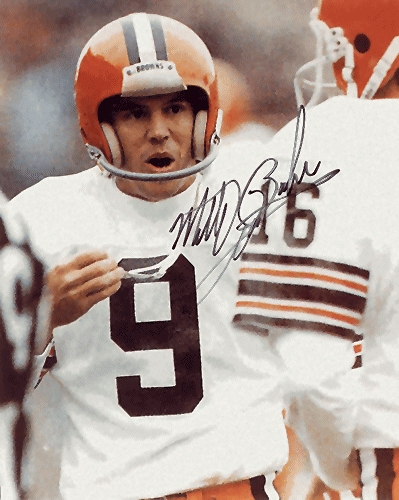 Matt Bahr - Browns - K - (1981-1989)
Matt Bahr - Browns - K - (1981-1989)
A consensus All-American at Penn State, Bahr had a 17 year NFL career, finishing 22nd on the all-time scoring list with 1422 points (305 FG); He was acquired by the Browns from San Francisco in October of 1981 to replace a struggling Dave Jacobs, and spent nine productive years kicking in Cleveland, arguably the prime years of his career. Sandwiched around his time in Cleveland, Matt Bahr won two Super Bowl rings (sigh). The first was in his rookie year with Pittsburgh (1979) and the other with NY Giants (XXV - 1991). Until last Sunday, and you-know-who, that 11-year span between Super Bowl victories was the longest for any NFL player. Bahr ranks 4th all-time in scoring for the Browns, with 677 points. He is remembered for a game-saving tackle on a kickoff return against Pittsburgh with the Browns clinging to a 31-28 lead. He tore up his knee on the play, but the Browns prevailed.
---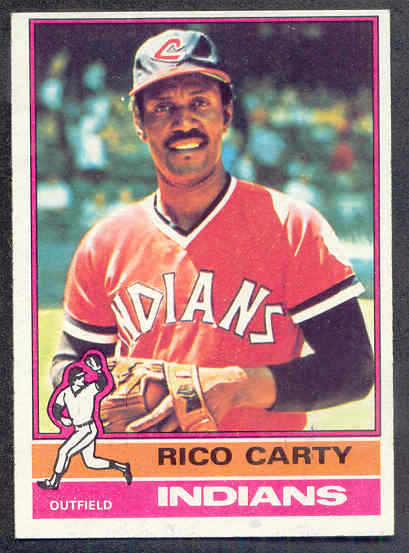 Rico Carty - Indians OF/DH (1974-1977)
Rico Carty - Indians OF/DH (1974-1977)
In four seasons as Tribe DH in the 70’s, the “Big Mon” hit .303, slugged .455, and had a .828 OPS. He played in just 33 games in 1974, but hit .363. He returned to play full seasons the next two years, and hit .308 in ‘75, and .310, with 13 HR and 83 RBI in ‘76 to lead the club in average and RBI. The former Rookie of the Year and NL batting champ was a veteran presence on a Tribe roster that needed one badly. He was named the Tribe's "Man of the Year" following that ‘76 season, but caused some controversy at the awards banquet the following spring, when he ripped into manager Frank Robinson for a “lack of leadership”, while Robinson sat at the head table. One funny Rico Carty story: A native of San Pedro de Macoris in the Dominican Republic, Carty was such a good prospect in the early 60’s that no less than 10 major league teams offered him contracts. Not knowing how these things worked, Carty signed them all. After the league sorted it all out, he was assigned to the Milwaukee Braves.
---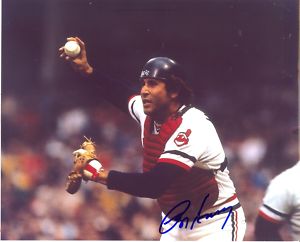
Besides the detail that he happened to wear the #9, Hassey would probably not be appearing here but for the fact that he is the answer to a great trivia question that all well-informed baseball fans (and especially Tribe fans) should remember, so as to impress their friends at the sports bar moment of their choosing. That question is: “Who is the only catcher in major league history to catch two perfect games?”
You’ll recall that I have already hinted at the answer. Hassey caught Len Barker’s 1981 masterpiece, and then, ten years later, in the last year of his career, he was behind the dish with the Expos for Dennis Martinez’ perfecto. So there you go.
---
on Twitter at @dwismar
---
- NBA Announces 2013-2014 Schedule
- Browns Ink Sharknado
- Sharknado A No-Show For Rookie Camp
- Trent Richardson Out Until Training Camp
- Browns Sign Brandon Jackson
- Carrasco Suspended Eight Games
- Browns Add to Wide Receiver Depth with David Nelson
- Browns Need to Learn from Past Draft Mistakes
- Browns Release Chris Gocong and Usama Young
- Browns Missing on Grimes Disappointing, But Not The End
The TCF Forums
- Chris Grant's first 3 drafts
Kingpin74 (Tuesday, January 21 2014 10:13 AM) - The 2014 Offseason Thread
googleeph2 (Tuesday, January 21 2014 9:36 AM) - 2015 Recruiting
furls (Tuesday, January 21 2014 6:57 AM) - Mike Brown
YahooFanChicago (Monday, January 20 2014 11:15 PM) - Movies coming out
HoodooMan (Monday, January 20 2014 9:34 PM) - 2014 Hoops Hockey Hijinx
jpd1224 (Monday, January 20 2014 4:44 PM) - 2014 Recruiting
jclvd_23 (Monday, January 20 2014 2:26 PM) - Wish List - #4 Pick
Hikohadon (Monday, January 20 2014 1:26 PM) - Official- Browns Coach Search/Rumors
OldDawg (Sunday, January 19 2014 6:48 PM) - #1 overall pick Anthony Bennett
TouchEmAllTime (Sunday, January 19 2014 1:28 PM)



